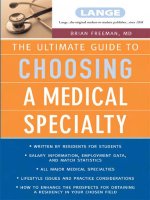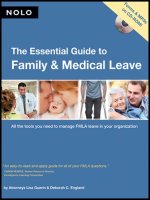THE ULTIMATE GUIDE TO CHOOSING A MEDICAL SPECIALTY docx
Bạn đang xem bản rút gọn của tài liệu. Xem và tải ngay bản đầy đủ của tài liệu tại đây (1.73 MB, 493 trang )
THE ULTIMATE GUIDE TO
CHOOSING
A MEDICAL
SPECIALTY
Brian Freeman, MD
Resident in Anesthesiology and Critical Care
University of Chicago Hospitals
Chicago, Illinois
And Associate Authors
Lange Medical Books/McGraw-Hill
Medical Publishing Division
New York Chicago San Francisco Lisbon London
Madrid Mexico City Milan New Delhi San Juan
Seoul Singapore Sydney Toronto
a LANGE medical book
Copyright © 2004 by The McGraw-Hill Companies, Inc. All rights reserved. Manufactured
in the United States of America. Except as permitted under the United States Copyright Act
of 1976, no part of this publication may be reproduced or distributed in any form or by any
means, or stored in a database or retrieval system, without the prior written permission of the
publisher.
0-07-145713-5
The material in this eBook also appears in the print version of this title: 0-07-141052-X.
All trademarks are trademarks of their respective owners. Rather than put a trademark symbol
after every occurrence of a trademarked name, we use names in an editorial fashion only, and
to the benefit of the trademark owner, with no intention of infringement of the trademark.
Where such designations appear in this book, they have been printed with initial caps.
McGraw-Hill eBooks are available at special quantity discounts to use as premiums and sales
promotions, or for use in corporate training programs. For more information, please contact
George Hoare, Special Sales, at or (212) 904-4069.
TERMS OF USE
This is a copyrighted work and The McGraw-Hill Companies, Inc. (“McGraw-Hill”) and its
licensors reserve all rights in and to the work. Use of this work is subject to these terms.
Except as permitted under the Copyright Act of 1976 and the right to store and retrieve one
copy of the work, you may not decompile, disassemble, reverse engineer, reproduce, modify,
create derivative works based upon, transmit, distribute, disseminate, sell, publish or
sublicense the work or any part of it without McGraw-Hill’s prior consent. You may use the
work for your own noncommercial and personal use; any other use of the work is strictly
prohibited. Your right to use the work may be terminated if you fail to comply with these
terms.
THE WORK IS PROVIDED “AS IS.” McGRAW-HILL AND ITS LICENSORS MAKE NO
GUARANTEES OR WARRANTIES AS TO THE ACCURACY, ADEQUACY OR
COMPLETENESS OF OR RESULTS TO BE OBTAINED FROM USING THE WORK,
INCLUDING ANY INFORMATION THAT CAN BE ACCESSED THROUGH THE
WORK VIA HYPERLINK OR OTHERWISE, AND EXPRESSLY DISCLAIM ANY
WARRANTY, EXPRESS OR IMPLIED, INCLUDING BUT NOT LIMITED TO IMPLIED
WARRANTIES OF MERCHANTABILITY OR FITNESS FOR A PARTICULAR
PURPOSE. McGraw-Hill and its licensors do not warrant or guarantee that the functions
contained in the work will meet your requirements or that its operation will be uninterrupted
or error free. Neither McGraw-Hill nor its licensors shall be liable to you or anyone else for
any inaccuracy, error or omission, regardless of cause, in the work or for any damages
resulting therefrom. McGraw-Hill has no responsibility for the content of any information
accessed through the work. Under no circumstances shall McGraw-Hill and/or its licensors
be liable for any indirect, incidental, special, punitive, consequential or similar damages that
result from the use of or inability to use the work, even if any of them has been advised of the
possibility of such damages. This limitation of liability shall apply to any claim or cause
whatsoever whether such claim or cause arises in contract, tort or otherwise.
DOI: 10.1036/0071457135
Want to learn more?
We hope you enjoy this
McGraw-Hill eBook! If
you’d like more information about this book,
its author, or related books and websites,
please click here.
For Rebecca
Without you, this book would never have been conceived. You are my
inspiration—each and every day—for all that I do and all that I hope to
achieve. Thank you for your love, for your never-ending support and
devotion, and for always being there with a soft “pet” whenever I need
one. I am yours forever.
This page intentionally left blank.
Internet Resources Guide . . . . . . . . . . . . . . . . . . . . . . . . . . Inside Front Cover
Authors . . . . . . . . . . . . . . . . . . . . . . . . . . . . . . . . . . . . . . . . . . . . . . . . . . . . . . xi
Preface . . . . . . . . . . . . . . . . . . . . . . . . . . . . . . . . . . . . . . . . . . . . . . . . . . . . . . xv
Part 1. Planning Your Medical Career
1. Choosing a Specialty: The Most Difficult Decision of Your Career 3
2. The Specialization of Medicine . . . . . . . . . . . . . . . . . . . . . . . . . . 13
3. Ten Factors to Consider in Specialty Selection . . . . . . . . . . . . . . . 23
4. Personality Assessment: Are You My Type? . . . . . . . . . . . . . . . . . . 35
5. Finding the Perfect Specialty . . . . . . . . . . . . . . . . . . . . . . . . . . . . 45
6. Special Considerations for Women . . . . . . . . . . . . . . . . . . . . . . . . 59
7. Combined Residency Programs . . . . . . . . . . . . . . . . . . . . . . . . . . 71
8. Options for the Undecided Medical Student . . . . . . . . . . . . . . . . 81
9. Applying for Residency: An Overview of the Match Process . . . . . 87
10. Love and Medicine: The Couples Match . . . . . . . . . . . . . . . . . . . 109
11. Top Secret! The Ultimate Guide to a Successful Match . . . . . . . . 119
12. Your Medical Career Beyond Residency . . . . . . . . . . . . . . . . . . . . 137
Part 2. Specialty Profiles
13. Anesthesiology . . . . . . . . . . . . . . . . . . . . . . . . . . . . . . . . . . . . . . . . 151
Brian Freeman, MD
14. Dermatology . . . . . . . . . . . . . . . . . . . . . . . . . . . . . . . . . . . . . . . . . 169
Amy J. Farmer, MD
15. Emergency Medicine . . . . . . . . . . . . . . . . . . . . . . . . . . . . . . . . . . 181
Jeremy Graff, MD
Contents
v
For more information about this title, click here
16. Family Practice . . . . . . . . . . . . . . . . . . . . . . . . . . . . . . . . . . . . . . . 199
Michael Mendoza, MD, MPH, and Lisa Vargish, MD, MS
17. General Surgery . . . . . . . . . . . . . . . . . . . . . . . . . . . . . . . . . . . . . . 213
Danagra Georgia Ikossi, MD and Jonathan Long Le, MD
18. Internal Medicine . . . . . . . . . . . . . . . . . . . . . . . . . . . . . . . . . . . . . 229
Jennifer Lamb, MD and Ian Tong, MD
19. Neurology . . . . . . . . . . . . . . . . . . . . . . . . . . . . . . . . . . . . . . . . . . . 251
Tomasz Zabiega, MD
20. Neurosurgery . . . . . . . . . . . . . . . . . . . . . . . . . . . . . . . . . . . . . . . . 267
M. Jafer Ali, MD
21. Obstetrics & Gynecology . . . . . . . . . . . . . . . . . . . . . . . . . . . . . . . . 281
Kelly Oberia Elmore, MD, LT, MC, USNR
22. Ophthalmology . . . . . . . . . . . . . . . . . . . . . . . . . . . . . . . . . . . . . . . 295
Andrew Schwartz, MD
23. Orthopedic Surgery . . . . . . . . . . . . . . . . . . . . . . . . . . . . . . . . . . . . 309
John C. Langland, MD
24. Otolaryngology . . . . . . . . . . . . . . . . . . . . . . . . . . . . . . . . . . . . . . . 321
Daniel J. Lee, MD
25. Pathology . . . . . . . . . . . . . . . . . . . . . . . . . . . . . . . . . . . . . . . . . . . 333
Lisa Yerian, MD
26. Pediatrics . . . . . . . . . . . . . . . . . . . . . . . . . . . . . . . . . . . . . . . . . . . 349
Aaron J. Miller, MD
27. Physical Medicine & Rehabilitation . . . . . . . . . . . . . . . . . . . . . . . 367
Vicki Anderson, MD, MBA
28. Plastic Surgery . . . . . . . . . . . . . . . . . . . . . . . . . . . . . . . . . . . . . . . 383
Gregory H. Borschel, MD
29. Psychiatry . . . . . . . . . . . . . . . . . . . . . . . . . . . . . . . . . . . . . . . . . . . 397
Kathleen Ang-Lee, MD
30. Radiation Oncology . . . . . . . . . . . . . . . . . . . . . . . . . . . . . . . . . . . 413
Stephanie E. Weiss, MD
vi CONTENTS
31. Radiology . . . . . . . . . . . . . . . . . . . . . . . . . . . . . . . . . . . . . . . . . . . 429
Derek Fimmen, MD
32. Urology . . . . . . . . . . . . . . . . . . . . . . . . . . . . . . . . . . . . . . . . . . . . . 443
Jane Lewis, MD
Index . . . . . . . . . . . . . . . . . . . . . . . . . . . . . . . . . . . . . . . . . . . . . . . . . . . . . .457
CONTENTS vii
This page intentionally left blank.
M. Jafer Ali, MD
Resident in Neurosurgery, Department of Neurosurgery, University of
Michigan Hospital, Ann Arbor, Michigan
Neurosurgery
Vicki Anderson, MD, MBA
Resident, McGaw Medical Center of Northwestern University, Rehabilitation
Institute of Chicago, Chicago, Illinois
Physical Medicine & Rehabilitation
Kathleen Ang-Lee, MD
Resident, Department of Psychiatry, University of Washington Medical Center,
Seattle, Washington
Psychiatry
Gregory H. Borschel, MD
The Ethel C. Coller Research Fellow, Department of Surgery; Plastic Surgery
Resident, Section of Plastic Surgery, University of Michigan Medical School,
Ann Arbor, Michigan
Plastic Surgery
Kelly Oberia Elmore, MD, LT, MC, USNR
Resident, Department of Obstetrics and Gynecology, Naval Medical Center,
San Diego, California
Obstetrics & Gynecology
Amy J. Farmer, MD
Resident, Division of Dermatology, University of Chicago Hospitals, Chicago,
Illinois
Dermatology
Authors
ix
Copyright © 2004 by The McGraw-Hill Companies, Inc. Click here for terms of use.
Derek Fimmen, MD
Resident, Department of Radiology, University of Chicago Hospitals, Chicago,
Illinois
dlfi
Radiology
Brian Freeman, MD
Resident in Anesthesiology and Critical Care, University of Chicago Hospitals,
Chicago, Illinois
Choosing a Specialty: The Most Difficult Decision of Your Career; The
Specialization of Medicine; Ten Factors to Consider in Specialty Selection;
Personality Assessment: Are You My Type?; Finding the Perfect Specialty;
Special Considerations for Women; Combined Residency Programs; Options
for the Undecided Medical Student; Applying for Residency: An Overview of
the Match Process; Love and Medicine: The Couples Match; Top Secret!
The Ultimate Guide to a Successful Match; Your Medical Career Beyond
Residency; Anesthesiology
Jeremy Graff, MD
Resident, Department of Emergency Medicine, Alameda County Medical
Center, Highland Hospital, Oakland, California
Emergency Medicine
Danagra Georgia Ikossi, MD
Resident in General Surgery, Department of Surgery, Stanford University
Medical Center, Stanford, California
General Surgery
Jennifer Lamb, MD
Resident, Department of Internal Medicine, Stanford University Hospitals,
Stanford, California
Internal Medicine
John C. Langland, MD
Orthopedic Surgeon, Steindler Orthopedic Clinic, Iowa City, Iowa
Orthopedic Surgery
x AUTHORS
Jonathan Long Le, MD
Resident in Plastic Surgery, Department of Plastic Surgery, University of
California, San Francisco
General Surgery
Daniel J. Lee, MD
Assistant Professor, University of Massachusetts Medical School; Director, The
Sounds of Life Center, UMass Memorial Medical Center, Worcester,
Massachusetts; Lecturer, Department of Otology and Laryngology, Harvard
Medical School, Boston, Massachusetts; Research Associate, Eaton-Peabody
Laboratory, Massachusetts Eye and Ear Infirmary, Boston, Massachusetts
Otolaryngology
Jane Lewis, MD
Resident in Urology, Harvard Program in Urology, Harvard Medical School,
Boston, Massachusetts
Urology
Michael Mendoza, MD, MPH
Resident, Family Practice Residency Program, University of California, San
Francisco and San Francisco General Hospital
Family Practice
Aaron J. Miller, MD
Attending Pediatrician, Jacobi Medical Center, Bronx, New York
Pediatrics
Andrew Schwartz, MD
Resident Physician, Mount Sinai School of Medicine, The Mount Sinai
Hospital, New York, New York
Ophthalmology
AUTHORS xi
Ian Tong, MD
Resident, Department of Internal Medicine, Stanford University Hospitals,
Stanford, California
Internal Medicine
Lisa Vargish, MD, MS
Resident, Family Practice Residency Program, University of California, San
Francisco and San Francisco General Hospital
Family Practice
Stephanie E. Weiss, MD
Chief Resident, Department of Radiation Oncology, The Sidney Kimmel
Comprehensive Cancer Center at Johns Hopkins, Baltimore, Maryland
Radiation Oncology
Lisa Yerian, MD
Resident, Department of Pathology, University of Chicago Hospitals, Chicago,
Illinois
Pathology
Tomasz Zabiega, MD
Attending Neurologist, Joliet Pain Center, and Medical Director of Practice
Developers of Illinois, Inc., Joliet, Illinois
Neurology
xii AUTHORS
Three years ago I was a confused third-year medical student, not having any idea
about the next step in my education and professional training. Deciding on a ca-
reer in medicine was easy; choosing a specialty, on the other hand, was agoniz-
ing. Like my classmates, I felt overwhelmed by the number of choices. I imag-
ined myself as a future surgeon or emergency medicine physician, but after
extensive research and clinical experiences, I soon discovered that anesthesiol-
ogy was the perfect fit. I realized at the time that medical students need a good
written resource to guide them through this difficult career-defining decision.
This is when the idea for The Ultimate Guide to Choosing a Medical Specialty
was born. Today’s doctor-in-training requires as much information as possible to
make a confident decision, but has little time to gather it. A single comprehen-
sive resource, this book provides detailed insight into each field and allows stu-
dents to quickly and easily compare specialties under consideration.
SPECIAL FEATURES
• An “insider’s look” into different areas of medicine—specialty chapters writ-
ten by residents who recently made their career decisions
• Candid and revealing descriptions of each specialty, including the pros and
the cons, plus salary information, employment data, match statistics, and
much more
• Profiles of the major medical specialties, including those to which medical
students may receive little exposure, such as radiation oncology
• A concise up-to-date guide to the residency application and matching pro-
cess, including a separate chapter dedicated to the “Couples Match”
• A special chapter with explicit advice to help medical students maximize
their success in obtaining a residency position in each field
ORGANIZATION
This book is organized into two major sections. Part 1, “Planning Your Medical
Career,” delves into the main issues surrounding the choice of one’s medical spe-
cialty. These 12 chapters provide everything you need to begin making this ma-
jor decision—how to research each specialty, what to do if you remain undecided,
how to apply for a residency position, and much more. This section is especially
Preface
xiii
Copyright © 2004 by The McGraw-Hill Companies, Inc. Click here for terms of use.
valuable if read early during your medical education. In Part 2, “Specialty Pro-
files,” a chapter is devoted to each of the 20 major medical disciplines, all fol-
lowing a similar format and exploring common themes. Interspersed throughout
the text are special inserts—“Vital Signs” and “The Inside Scoop”—that provide
easy-to-read factoids like salary information and match statistics.
AUDIENCE
Most readers interested in this book are current medical students—allopathic and
osteopathic, and those who attend medical school in the U.S. and abroad. But
you do not have to be a medical student in order to get something out of this
book. Many residents have second thoughts about their chosen specialty and wish
to change fields. In addition, pre-medical college students, as well as anyone con-
sidering medicine as a possible career, will find this book helpful.
FEEDBACK
For comments and suggestions about the book, you are invited to contact the au-
thor by e-mail () or by regular mail:
Brian Freeman, MD
c/o McGraw-Hill
Medical Publishing Division
2 Penn Plaza, 12th floor
New York, NY 10121-2298
Your feedback is invaluable for continuing to make this book a must-have re-
source for future medical students. If you have questions regarding specific areas
of medicine, you may e-mail the contributor of that specialty chapter. Their bi-
ographical and contact information can be found at the end of each chapter.
ACKNOWLEDGMENTS
Many people helped make this book a reality. I first would like to acknowledge
my mother, Ellen, for all her guidance, love, and support throughout my life. I
also owe a huge debt of gratitude to the following people who shared their en-
couragement and advice: Eric Freeman, Gertrude Eichschlag, Victor Osinaga,
Derek Fimmen, and Dr. William McDade, who graciously spent time reviewing
my own specialty chapter. A special “meow” goes out to Foo and Casper, our two
xiv PREFACE
Cornish Rex cats who kept my lap warm on cold winter nights while writing this
book.
In the medical publishing division of McGraw-Hill, a fantastic team of edi-
tors helped bring this book into creation. Shelley Reinhardt, the editor-in-chief,
went out of her way to nurture a new author. Susan Meigs offered unparalleled
editing expertise and countless useful suggestions that were right on target. The
entire copyediting and production team turned words and thoughts into a reader-
friendly and fun package.
I especially thank the extraordinary writers who contributed chapters on their
specialties for this book. Even while under the stress and hardship of being a res-
ident, their passion for their chosen careers shines through in their work. This
special group of physicians includes Jafer Ali, Vicki Anderson, Kathleen Ang-Lee,
Gregory Borschel, Kelly Elmore, Amy Farmer, Derek Fimmen, Jeremy Graff,
Danagra Ikossi, Jennifer Lamb, John Langland, Jonathan Le, Daniel Lee, Jane
Lewis, Michael Mendoza, Aaron Miller, Andrew Schwartz, Ian Tong, Lisa Var-
gish, Stephanie Weiss, Lisa Yerian, and Tomasz Zabiega.
Brian Freeman, MD
Chicago, Illinois
December 2003
PREFACE xv
This page intentionally left blank.
1
PLANNING
YOUR
MEDICAL
CAREER
Copyright © 2004 by The McGraw-Hill Companies, Inc. Click here for terms of use.
This page intentionally left blank.
Throughout their education, medical students never stop hearing these kinds of
comments. Starting from the moment of acceptance into medical school, these ques-
tions continue well into the final year of earning the MD. As they undertake the first
major professional decision of their career, medical students often struggle to come
up with a good answer. After all, it seems like just about everyone has a strong opin-
ion on the “best” specialty for a future doctor. That person could be an advisor, par-
ent, supervising physician, or even Aunt Betty at the annual family reunion. From anes-
thesiology to urology, there are over 60 specialties and subspecialties (Table 1–1).
How will a medical student make an educated decision?
“MD” REALLY STANDS FOR “MAJOR DECISIONS”
Medicine is a profession that requires overwhelming sacrifice and commitment.
You have to spend over $200,000 for four years of rigorous education, followed
by many long, tough years of on-the-job training. Like life in general, many im-
portant decisions line the road to becoming a doctor. Think back to the day when
1
CHOOSING A
SPECIALTY: THE MOST
DIFFICULT DECISION
OF YOUR CAREER
“Is it true that gynecologists have the worst sex lives of all doctors?”
“Are you going to be a neurosurgeon like your mother?”
“Why don’t you look into dermatology? It’s got easy hours and you’ll make good money.”
3
Copyright © 2004 by The McGraw-Hill Companies, Inc. Click here for terms of use.
you decided on a career in medicine. Whether you were a college student, try-
ing to pick between medicine, engineering, or public policy or perhaps an older,
nontraditional applicant who chose to leave a well-paying—but unrewarding—
job for a new calling in medicine, it was one of life’s biggest decisions. After slog-
ging through tedious premedical courses and the application process, you then
made the choice of where to attend medical school.
4 PART 1 / PLANNING YOUR MEDICAL CAREER
TABLE 1–1
RECOGNIZED MEMBERS OF THE AMERICAN BOARD OF MEDICAL SPECIALTIES (ABMS)
SPECIALTY BOARD YEAR OF FOUNDING
Allergy and immunology 1971
Anesthesiology 1941
Colon and rectal surgery 1949
Dermatology 1932
Emergency medicine 1979
Family practice 1969
Internal medicine 1936
Medical genetics 1993
Neurological surgery 1940
Nuclear medicine 1971
Obstetrics and gynecology 1930
Ophthalmology 1917
Orthopedic surgery 1935
Otolaryngology 1924
Pathology 1936
Pediatrics 1933
Physical medicine and rehabilitation 1947
Plastic surgery 1941
Preventive medicine 1949
Psychiatry and neurology 1935
Radiology 1935
Surgery 1937
Thoracic surgery 1970
Urology 1935
Source: American Board of Medical Specialties.
Now, another career-defining challenge awaits. The medical school experi-
ence is more than just memorizing the arteries of the arm, holding retractors dur-
ing surgery, and learning how to use a stethoscope. Each and every medical stu-
dent has to go through four years of grueling examinations, sleepless nights on
call, and tough clinical rotations. Despite these hurdles, most medical students
see eye to eye on what is really the greatest challenge of all—choosing one’s med-
ical specialty. Figuring out what type of doctor to be is, in many ways, more dif-
ficult than deciding to become a physician. Once medical students settle on a
specific niche within medicine, they become more than just future doctors. They
start to take on a new identity—that of a pediatrician, forensic psychiatrist, en-
docrinologist, orthopedic surgeon, or interventional neuroradiologist.
The specialties themselves are quite diverse. Graduating doctors have the
freedom to choose from a wide variety of medical fields. Some are based strictly
on an organ system, like the brain (neurosurgery and neurology), the heart (car-
diology), and the male genitourinary system (urology). Others provide compre-
hensive medical care for specific population groups, such as women (obstetrics
and gynecology) and children (pediatrics). Another set of specialties share in com-
mon the fact that they are hospital-based services. Its members include radiology,
pathology, anesthesiology, and emergency medicine. Medical specialties can also
generally be divided into two main groups: primary care (long-term comprehen-
sive care) versus secondary/tertiary care (referral-based care). Generalist special-
ties like family practice, internal medicine, and pediatrics are considered primary
care fields. More specialized areas such as gastroenterology, dermatology, and car-
diothoracic surgery fall into the latter category.
Everyone knows that medical school has many rigorous demands: patient
care, lectures, rounds, examinations, and call schedules all compete for a med-
ical student’s time, often crowding out sleep and a personal life. As a result, most
students have even less time for the proper self-assessment, research, and explo-
ration required to choose the right specialty. Every medical student agrees that it
is the most difficult professional decision that they will have to make. Yet most
will probably spend more time researching what kind of car to buy! In the end,
many hastily choose their lifetime careers without having all the information they
need to make an educated decision.
This book is designed to help medical students make an informed choice by
the time senior year rolls around. Deciding on a field of medicine is often de-
scribed as matching oneself with the characteristics of a particular specialty, such
as lifestyle, intellectual challenge, technological focus, and research potential.
Because of these factors, there is much confusion, frustration, and uncertainty
CHAPTER 1 / CHOOSING A SPECIALTY 5
involved in this defining moment of a young physician’s career. Poor decision-
making can have considerable implications for one’s professional happiness later
in life.
INTERNSHIP, RESIDENCY, AND FELLOWSHIP
Medical school is only the first step in learning how to become a competent, car-
ing physician. There are three different types of on-the-job training that com-
mence immediately following graduation from medical school. These avenues
take young, inexperienced doctors and turn them into well-trained specialists,
ready to cure disease and save lives. Choosing a specialty determines what form
of further professional training is required after medical school. Today’s medical
student, therefore, needs a clear understanding of the structure of postgraduate
medical education.
Medical students have to commit to their specialty to begin the next phase
in training: residency. During the past 60 years, rapid advancements in medical
science created a greater demand for specialists, which residency programs ex-
panded to meet. Depending on the specialty, residency consists of 3 to 7 years of
additional formal training and study (under physician supervision). Medical
school only provides a broad clinical foundation. Residency takes it one step fur-
ther and confers the skills, knowledge, and experience necessary to practice med-
icine unsupervised in a given specialty. Being a resident physician is kind of like
working as an indentured servant. You work long hours for little pay and spend
many nights sleeping in the hospital. In fact, residency earned its name from the
old days when house staff physicians actually lived on hospital grounds, as resi-
dents.
Through the National Resident Matching Program, graduating medical stu-
dents may enter residency training in 20 different specialties. You actually have
even more options. Here is why. The American Board of Medical Specialties
(ABMS) recognizes 24 official specialty boards. But every year, statistical data
from the residency match show that nearly all medical students enter 1 of only
20 areas. What about the remaining four? Three of the specialties—medical ge-
netics, preventive medicine, and nuclear medicine—offer such a small handful
of residency positions (16 total in 2002) that few students really consider them as
options. The other disciplines—allergy medicine and thoracic and colorectal sur-
gery—are really considered subspecialties of internal medicine and surgery, re-
spectively. (Psychiatry and neurology both share the same specialty board, and
radiation oncology falls under the jurisdiction of radiology). In addition, students
6 PART 1 / PLANNING YOUR MEDICAL CAREER
may also select more than one specialty through the combined residency pro-
grams described in Chapter 7. Doing the math, these 14 available options bring
the grand total to 34 choices.
After deciding on a specialty for residency, many physicians later choose to
subspecialize further by obtaining a fellowship, which can last any number of
years. Subspecialties exist for nearly every specialty. Examples include rheuma-
tology or infectious disease (internal medicine), vascular surgery (general sur-
gery), pain management (anesthesiology), and retinal surgery (ophthalmology).
Because of all the subspecialties, there are over 60 different kinds of doctors out
there! You can be an adolescent medicine specialist, critical care physician, or
interventional radiologist. The choices seem endless. Because areas of subspe-
cialization are primarily of interest to current residents-in-training, they will not
be a major focus of this book. It is important to remember, however, that these
fields are all potential career paths. Do not exclude them from your mind while
you are contemplating and exploring the 20 basic specialties. Having so many
additional options just means the decision gets even tougher.
Where does internship fit into all this? In the old days (prior to 1970), all
graduating medical students completed a 1-year rotating internship before en-
tering residency. This busy year consisted of all the core specialties: internal med-
icine, surgery, pediatrics, obstetrics and gynecology, and psychiatry. The goal was
to provide broad hands-on training that would enable a new physician to work in
the community as a general practitioner. After the demise of the formal intern-
ship in 1970, only the lingo lives on today. Internship is now simply considered
the first postgraduate year (PGY-1) of residency. In most hospitals, newly minted
MDs, fresh out of medical school, are usually known as first-year residents rather
than interns. The old internship does still exist in a disguised form: the transi-
tional year residency. This track (along with other 1-year programs) is discussed
further in Chapter 9.
WHY HAS CHOOSING A SPECIALTY BECOME SO DIFFICULT?
Medical Students Are Faced With More Choices Than
Ever
Back in the old days of medicine, the career options for a graduating medical stu-
dent were pretty simple: become a general practitioner, or become a general
practitioner. Medicine has changed quite a bit since that era. New discoveries in
science, advancements in medical care, and high-tech innovations paved the way
CHAPTER 1 / CHOOSING A SPECIALTY 7









